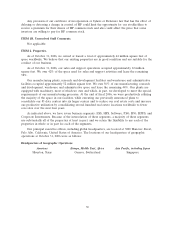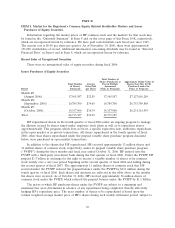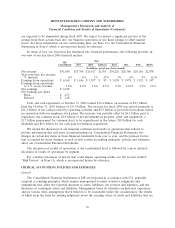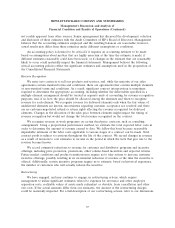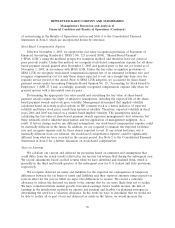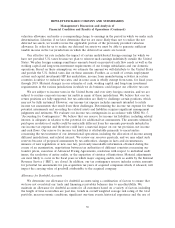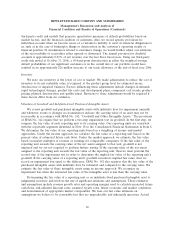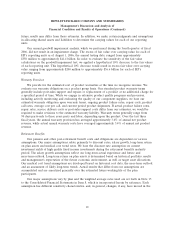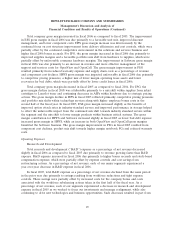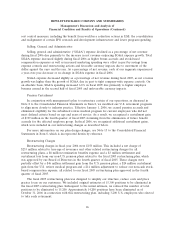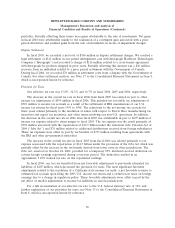HP 2006 Annual Report Download - page 43
Download and view the complete annual report
Please find page 43 of the 2006 HP annual report below. You can navigate through the pages in the report by either clicking on the pages listed below, or by using the keyword search tool below to find specific information within the annual report.HEWLETT-PACKARD COMPANY AND SUBSIDIARIES
Management’s Discussion and Analysis of
Financial Condition and Results of Operations (Continued)
valuation allowance and make a corresponding charge to earnings in the period in which we make such
determination. Likewise, if we later determine that we are more likely than not to realize the net
deferred tax assets, we would reverse the applicable portion of the previously provided valuation
allowance. In order for us to realize our deferred tax assets we must be able to generate sufficient
taxable income in the tax jurisdictions in which the deferred tax assets are located.
Our effective tax rate includes the impact of certain undistributed foreign earnings for which we
have not provided U.S. taxes because we plan to reinvest such earnings indefinitely outside the United
States. We plan foreign earnings remittance amounts based on projected cash flow needs as well as the
working capital and long-term investment requirements of our foreign subsidiaries and our domestic
operations. Based on these assumptions, we estimate the amount we will distribute to the United States
and provide the U.S. federal taxes due on these amounts. Further, as a result of certain employment
actions and capital investments HP has undertaken, income from manufacturing activities in certain
countries is subject to reduced tax rates, and in some cases is wholly exempt from taxes, for fiscal years
through 2019. Material changes in our estimates of cash, working capital and long-term investment
requirements in the various jurisdictions in which we do business could impact our effective tax rate.
We are subject to income taxes in the United States and over sixty foreign countries, and we are
subject to routine corporate income tax audits in many of these jurisdictions. We believe that our tax
return positions are fully supported, but tax authorities are likely to challenge certain positions, which
may not be fully sustained. However, our income tax expense includes amounts intended to satisfy
income tax assessments that result from these challenges. Determining the income tax expense for these
potential assessments and recording the related assets and liabilities requires significant management
judgments and estimates. We evaluate our income tax contingencies in accordance with SFAS No. 5,
‘‘Accounting for Contingencies.’’ We believe that our reserve for income tax liabilities, including related
interest, is adequate in relation to the potential for additional tax assessments. The amounts ultimately
paid upon resolution of audits could be materially different from the amounts previously included in
our income tax expense and therefore could have a material impact on our tax provision, net income
and cash flows. Our reserve for income tax liabilities is attributable primarily to uncertainties
concerning the tax treatment of our international operations, including the allocation of income among
different jurisdictions, and related interest. We review our reserves quarterly, and we may adjust such
reserves because of proposed assessments by tax authorities, changes in facts and circumstances,
issuance of new regulations or new case law, previously unavailable information obtained during the
course of an examination, negotiations between tax authorities of different countries concerning our
transfer prices, execution of Advanced Pricing Agreements, resolution with respect to individual audit
issues, the resolution of entire audits, or the expiration of statutes of limitations. Material adjustments
are most likely to occur in the fiscal years in which major ongoing audits, such as audits by the Internal
Revenue Service (‘‘IRS’’), are closed. In addition, our tax contingency reserve includes certain amounts
for potential tax assessments for pre-acquisition tax years of acquired companies which, if released, will
impact the carrying value of goodwill attributable to the acquired company.
Allowance for Doubtful Accounts
We determine our allowance for doubtful accounts using a combination of factors to ensure that
we have not overstated our trade and financing receivables balances due to uncollectibility. We
maintain an allowance for doubtful accounts for all customers based on a variety of factors, including
the length of time receivables are past due, trends in overall weighted average risk rating of the total
portfolio, macroeconomic conditions, significant one-time events, historical experience and the use of
39



